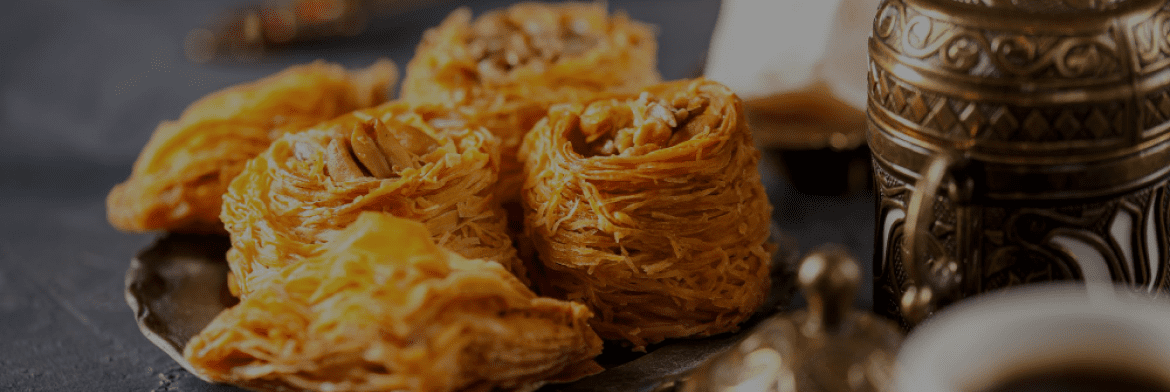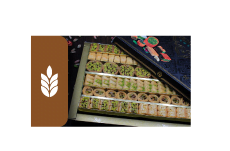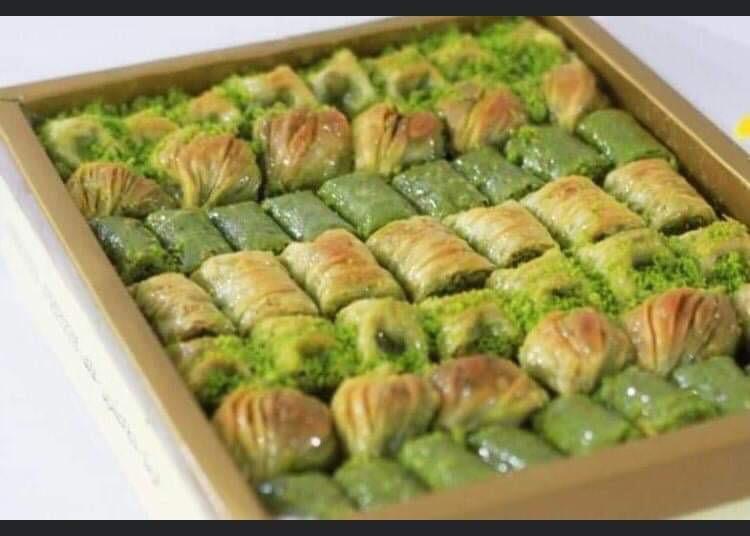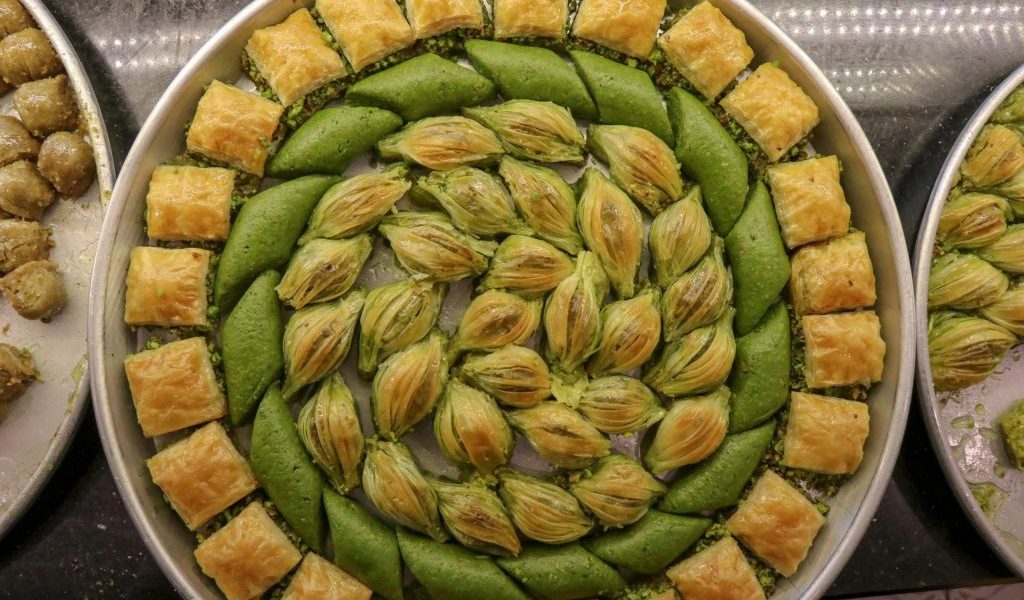
Blog
Baklava with pistachios

Pistachio baklava is the most delicious dessert
When tasting baklava, you feel the richness of its taste, in addition to the secrets hidden in its golden layers, methods and ingredients, but baklava is not limited to one type or one place, as the magic of its delicious taste extends in many regions, as its ingredients, types and shapes vary from one place to another.
What is baklava?
Baklava is considered one of the most delicious desserts, as it consists of crisp, easy-to-eat layers of dough with different fillings ranging from pistachios, hazelnuts, cashews, or even cream.
Baklava word
The origin of the word baklava is due to being an Ottoman Turkish word and used in many different languages, and it was introduced to the English language in 1650, and it came derived from its Turkish origin, but according to Hans Fehr's dictionary, the popular representation of the Arabic word baklava is a percentage of the word legumes, due to the entry of peanuts in the preparation of this dessert as a basic filling in the beginning, and then varied after that to be pistachios, hazelnuts, cashews and the most delicious and delicious types of nuts.
Baklava nomenclature
There were different and many sayings about the naming of baklava, but the most famous is that it came after the name of the wife of one of the Ottoman sultans, and in another novel it was said that it was named due to the use of a type of legumes in its ingredients and numbers, but the most famous novel of all came when the cook of the Ottoman Sultan known as "Lawa" prepared it, and it was a new variety then, so when the Sultan tasted it for the first time, he was very impressed and said "Baklava", which means her act of Lawa and was an honor for her at the time and therefore called baklava.
Baklava's history with the Ottoman Empire
The Sultan used to distribute trays of baklava to the Janissary units and other military units in Istanbul, provided that every ten people had a tray of baklava, and they used to make big celebrations when the trays of Turkish baklava were transferred from one place to another, and the soldiers would take the remaining trays for each nafran tray. They were distributed and transported in a special system, where Silahdar Agha starts first and takes the first two trays in the name of the Sultan because the Sultan considers the Janissary to be the first number, and the soldiers take the remaining trays for each tray; they pass a greased and well-covered wood and carry the tray on their shoulders. The heads of each regiment walk in front, and the tray bearers walk behind them, as Turkish baklava was one of the basics of celebrations in the modern Turkish state and the old Ottoman Empire, where a special procession known as the baklava procession appeared in the middle of Ramadan in the late seventeenth century AD, and from here, baklava became one of the most famous types of sweets that are served on modern occasions and celebrations as well.
Learn about the origin of baklava
In 2013, the European Commission imposed a stamp of origin on baklava exported from Gaziantep, a city in southern Turkey, and thus baklava was recognized as a Turkish product, although Arab countries attribute types of baklava and sweets to their local industry and traditional folklore. Baklava may have traveled from Turkey to the rest of the empire, where its manufacture, configurations, and types varied from region to region. Confectioners throughout Greece, the Middle East and beyond challenge the Turks' claims about baklava. Baklava is found everywhere from Morocco to Iran and Saudi Arabia, and the shapes, types, ingredients, nuts, spices and seasonings may vary, but the syrup (tar) remains the same in all forms and manufacturing methods.
The Battle of Baklava between Greeks and Turks
The dispute started with some European posters depicting the Turkish dessert as the national dish of Greek Cypriots. The poster was issued among other posters about the most famous desserts in the countries of the Union, on the occasion of Europe Day sponsored by the European Union, and according to Reuters, this poster sparked the "baklava battle" between Turks and Greek Cypriots, which developed into marches in Istanbul in the Sultanahmet neighborhood and the participation of 200 baklava makers in Turkey, and at the same time Reuters reported that an aide to Ali Babacan, head of Turkey's delegation in negotiations with the European Union, pledged to raise the issue of the baklava dispute at the EU headquarters in Brussels, and the baklava battle is one of many food fights involving Middle Eastern countries and the Meto-Mediterranean Sea
Learn about the types of baklava
Creamy pistachio baklava: A type of traditional Turkish dessert, made from a mixture of cream and pistachios.
Burma baklava: Baklava is a thin, round-rolled dough roll filled with walnuts or pistachios.
Pistachio roll baklava: It is a baklava made from pistachios and is one of the most popular names for Turkish baklava.
Iranian baklava:
Iranian baklava differs from other types of baklava in that it is made with a specific number of crisp dough flakes as well as saffron, coconut, and nuts all mixed together.
Greek baklava:
It is made from 33 layers of dough and symbolizes the years that Christ lived in the Greek state, and its ingredients include honey, walnuts, and cinnamon, which adds a different taste to it.
Algerian baklava:
The number of layers of dough that are used in the preparation of baklava in Algeria varies according to each region and each city, and its ingredients include sugar, almonds and walnuts, which makes it have a unique taste specific to the country that serves it.
Baklava with walnuts: Walnut baklava is popular in the Aegean region, and it's also one of the most delicious types of baklava
Baklava with hazelnuts: Hazelnut baklava is very popular in Arab countries and around the world, especially in the Black Sea region.
Azerbaijani baklava:
It is prepared from crisp dough flakes and includes almonds and Turkish nuts that give it a special and different taste, and it is cut in a parallel shape and is one of the most famous desserts that are served on holidays and occasions.
In the end, baklava is one of the Arabic oriental sweets that traveled the whole world, which also united most opinions and tastes, so we rarely find disagreement on it, because it varied in its fillings to suit all tastes and opinions.


